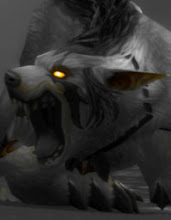If the tank dies, it's the healer's fault.I take exception to this adage, and think it conveys a bad attitude and is disrespectful to damage dealing classes. If the tank dies because he's wearing spellpower gear and is not talented into mitigation or avoidance, it is not the healer's fault.
If the healer dies, it's the tank's fault.
If the DPS dies, it's their own damned fault.
This is just one example where the adage fails. We need to be honest about survivability.
If the point of the game were merely to stay alive, then a tank and four healers would be the optimal group composition. However,
The first duty of a tank is not to stay alive, but to keep their party alive and buy them time to bring down the quarry. Staying alive is merely a habit in keeping with that primary goal.Every member of the party is responsible for accomplishing the overall goal, which is to bring down the quarry. The responsibilities of the different roles can and do overlap.
For example, if the tank dies, it might be the damage dealer's fault. Whenever a mob parries a frontal melee attack, they get a ~40% haste buff on their next white damage attack. This means if you're standing shoulder-to-shoulder with three melee damage dealers, and none of them are expertise capped to remove the 12-15% parry chance, you will be taking a lot more damage than usual.
Yes, it is one of the melee DPS's responsibilities not to contribute damage to the tank. This further disproves the adage above.
If one of your damage dealers is a Fury Warrior with 0 Expertise skill, and you're trash tanking four mobs, each of their whirlwind attacks (assuming a 13.5% parry chance on each of the four mobs) are ~44% likely to proc the haste debuff on one of the mobs.
This is why you, the tank, should always be on the other side of a mob from your melee damage dealers. Always. Mobs can't parry attacks from behind them, so the damage dealers will be much more effective if you coordinate to keep the mob's backside pointing at the party (unless it's a dragon).
Once we accept that the tank and the melee damage dealers should always be on opposite sides of a mob, the tank becomes partially responsible for where the melee damage dealers are standing. When the tank moves, the mob moves, and when the mob moves, the DPS must also move, in order to stay behind or to the side of it. The question for the tank becomes where shall I place my melee DPS?
Acknowledging that some fights are just plain messy, accidents happen, and nobody is perfect, we should still do our best as tanks to keep our melee damage dealers safe. For starters, we should not put our melee DPS in any place where:
- They can body pull.
- Their abilities can pull.
- They can be flung into a mob or other damage source.
So, how can you, as a tank, avoid some of these common pitfalls? The answer is by planning and practicing melee formations. Over the course of the next couple of weeks, I will begin a series of short articles describing various melee formations--general positioning strategies for party members that are not encounter specific. The goal will be to outline the advantages and disadvantages of each formation, and to provide videos that illustrate them in use with melee damage dealers. Because other websites such as TankSpot have encounter-specific raid videos, I will focus on formations for general use.

I find tanking mixed groups of casters and melee the hardest part of being a bear. Any advice you have on dealing with those groups would be brilliant.
ReplyDeleteSounds good!
ReplyDeleteHowever you comment
"If the tank dies because he's wearing spellpower gear and is not talented into mitigation or avoidance, it is not the healer's fault."
Is a little bit silly. Any tank not wearing the appropriate gear isnt a tank, he/she is a liability and nothing more!
What the 3 rules are saying is that based on the smooth fight. (Ie boss stays on the tank all the time and dps, dps as well as they can)
Then if the tank dies its because the healer couldn't keep him healed. If the healer dies its because the tank lost control of the boss. If the DPS die then its because they couldn't control their DPS and stole threat.
Obviously with certain boss gimmicks and no fight ever being straight forwars you have to take the comment with a pinch of salt but i still think if you look at it the right way the old addage still stands!
@merlot:
ReplyDeleteI just accidentally started a blog, trying to comment on your question. I put the comment in a post here:
http://hybridenvy.blogspot.com/
@Etaiu:
Thank you for the focused blog. I check every day for some more tanking goodness.
Etaiu, thank you for this consistently sage blog.
ReplyDeleteYou are touching on an aspect I currently find myself struggling to explain to new tanks in my guild--I look forward to pointing them here!
As you point out, there's basically one desired party formation: (wall) Tank Enemy Melee Ranged.
Like Merlot, I find the issue is how to handle various mob formations to achieve the desired party formation.
But then, I'd never considered flying bear as a standard pull, so I'm eager to see your take on party formations :)